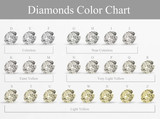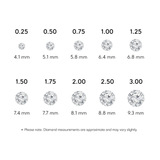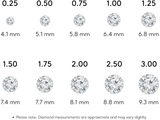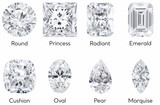

Diamond Education
Diamonds come in various colors, shapes, and sizes. But there's more to it than just that. We all know about the 4 C's - Color, Clarity, Cut, and Carat Weight. Read on to find out what leading online diamond store manufacturers do.
Every diamond is unique, regardless of whether it is mined from the earth or grown in a lab. Even though there are perfect diamonds, most diamonds found in diamond engagement rings and fine jewelry are "imperfect". Diamonds are a personal choice based on how big, how perfect, and how much you value the diamond shape. Selecting the perfect real diamond earrings, rings, pendants, or bracelets also involves choosing the diamond clarity scale, cut, diamond color, diamond value, and carat weight. Get to know the 4Cs of Diamonds to make an informed buying decision.
Diamond cut
Diamond cut
The term cut refers to the geometric proportions of a gemstone. The best diamond cut of a gemstone is one of the most important factors in determining how much sparkle a gemstone produces. Once the diamond shape has been determined, facets are cut. Different cuts of diamonds refract light like a prism to produce the stone’s fire and brilliance. Diamonds are cut to reflect as much light as possible. The ideally cut diamond possesses good symmetry. Of course, diamonds must also have excellent polish and high luster.
Here is the diamond cut scale:
- Ideal
- Premium
- Very Good
- Good
- Fair & Poor


Diamond Color
Diamond Color
The diamond color chart refers to its lack of color. Each letter on the diamond grading scale represents a narrow color range, not a specific point.
What is The Best Color For Diamond?
There are various colors in the diamond color scale. However, it is important to understand the difference between each diamond color and what they showcase. Below we have described each diamond color and the differences among them.
D - F grades are colorless. The differences between these grades are very slight.
G - J grades are nearly colorless. They have slight traces of color that aren't noticeable to untrained eyes.
K - M grades are faint yellow. When mounted, small stones look almost colorless, but large stones show a hint of yellow.
N - R grades are very light yellow. They appear very light yellow even when they are mounted in jewelry.
S - Z grades are light yellow. They show substantial color face-up or face-down, loose or mounted.


Diamond clarity
Diamond clarity
Diamond grades are rated according to their clarity or the size and color of flaws, or inclusions.
Flawless and nearly flawless diamonds, with a diamond clarity scale between FL and VVS2, are considered particularly rare and are, consequently, expensive.
Inclusions can hinder how the diamond reflects light, reducing the brilliance and prismatic effect of color in a diamond. VVS and VS grades have tiny inclusions that may be seen only by a trained professional under magnification of ten times the actual size.
An SI diamond clarity implies that the diamond contains inclusions but it is still clean to the human eye.
I1-I3 diamonds contain inclusions that may include larger clouds or feathers. They may be visible to the unaided eye and may exhibit lower brilliance and transparency. In this diamond clarity and color chart we have defined diamond clarity rating and their grades to understand the diamond grades and clarity in detail. Check out the diamond color and clarity chart for a detailed overview.


Diamond carat
Diamond carat
A carat diamond is a unit of weight used in the diamond trade that equals 200 milligrams or 1/5th a gram.
It is important to note that diamond carat refers to a unit of weight and not a measurement of size. This means that 2 same diamond carat size weight may have different measurements.
Large diamond size is rare and thus more expensive per carat than their smaller counterparts.
Therefore, a 4-carat diamond might be 10 times the price per carat of a comparable half-carat diamond.
When selecting the best carat weight, it is best to take into consideration your partner’s taste, style, finger size, and the type of band or setting.


Beyond the 4Cs
Diamond shape
Diamond shape
You can think of your diamond's shape as its outline. It's the physical and visual form of the stone.
Diamond cut scale and shape possess different qualities that influence their sparkle and appearance.
Diamond ring shapes are frequently one of the first attributes that couples consider when shopping.
Despite the popularity of round diamonds, many couples also prefer the unique appearance of fancy shaped diamonds.
There are many types of fancy shaped diamonds, including princess, radiant, emerald, cushion, oval, pear, and marquise diamonds.


Impact of other factors
Two diamonds with identical color, cut, clarity and carat weight can have over 1,560 different value classifications. If you take into account other important factors, such as florescence and symmetry, there are over 20,000 different diamond value classifications, each with its own market price. Even within these classifications, there may be additional subclassifications such as borderline colors, position of an inclusion within a diamond and grading subjectivity.
fluorescence
Diamonds with high fluorescence exhibit a bluish glow in many different types of lighting. This can dramatically reduce the value and appeal of a diamond.
types of imperfections
There are several types of imperfections such as carbon, feather and whisp imperfections. All imperfections fall into two primary categories: white imperfections and black imperfections. White or transparent imperfections are far more desirable than black or opaque imperfections.
size & location of imperfections
Imperfections can occur anywhere in a diamond. The most desirable imperfection is located on the edge or side of the diamond and can be easily hidden under a prong.
internal brilliance/fire
Each individual diamond can exhibit a fabulous amount of brilliance based on the extent to which it refracts light. This is determined by the depth and table of diamond.
symmetry
Symmetry refers to the exactness of the shape and arrangement of facets, or cut surfaces. Most well-cut diamonds have 58 facets and it is important that facets are shaped correctly, centered and properly aligned.
millimeter measurements
Diamonds are extremely small for how valuable they are. Believe it or not, cutting a diamonds at the wrong angle can throw off important ratios and make large stones seem much smaller than they actually are. Even if size is not your top priority, you should be sure to get a well-cut diamond with proper ratios so your jewels look as good as they cost.

